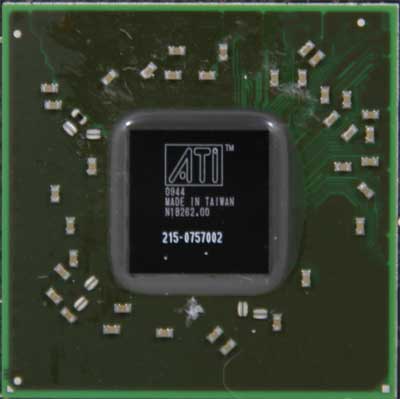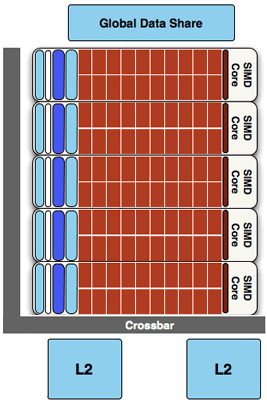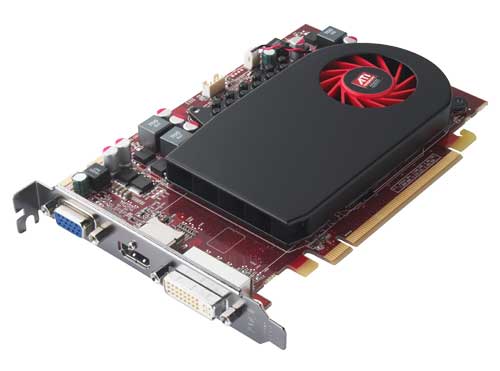AMD's Radeon HD 5670: Sub-$100 DirectX 11 Starts Today
by Ryan Smith on January 14, 2010 12:00 AM EST- Posted in
- GPUs
After a holiday break, AMD’s staggered launch of the Evergreen family picks back up today with the launch of the Radeon HD 5670. The 5670 marks the desktop launch of Redwood, the 3rd chip in the Evergreen family, designed to fit in below the Juniper chip that powers the Radeon HD 5700 series.
| ATI Radeon HD 5750 | ATI Radeon HD 4850 | ATI Radeon HD 4770 | ATI Radeon HD 5670 | ATI Radeon HD 4670 | |
| Stream Processors | 720 | 800 | 640 | 400 | 320 |
| Texture Units | 36 | 40 | 32 | 20 | 32 |
| ROPs | 16 | 16 | 16 | 8 | 8 |
| Core Clock | 700MHz | 625MHz | 750MHz | 775MHz | 750MHz |
| Memory Clock | 1.15GHz (4.6GHz data rate) GDDR5 | 993MHz (1986MHz data rate) GDDR3 | 800MHz (3200MHz data rate) GDDR5 | 1000MHz (4000MHz data rate) GDDR5 | 1000MHz (2000MHz data rate) GDDR3 |
| Memory Bus Width | 128-bit | 256-bit | 128-bit | 128-bit | 128-bit |
| Frame Buffer | 1GB / 512MB | 1GB / 512MB | 512MB | 1GB / 512MB | 1GB / 512MB |
| Transistor Count | 1.04B | 956M | 826M | 627M | 514M |
| TDP | 86W | 110W | 80W | 61W | 59W |
| Manufacturing Process | TSMC 40nm | TSMC 55nm | TSMC 40nm | TSMC 40nm | TSMC 55nm |
| Price Point | $129 - $149 | $99-$129 | $129 | $99 / $119 | $60-$90 |
AMD has been relatively straightforward in designing the Evergreen family. Each chip is half of its bigger brother. This means that the Redwood chip and the 5670 is in most ways half of a Juniper/5770: half the SIMDs (400), half the ROPs (8), half the texture units (20), etc. The core clocks are also slightly changed compared to the 5870 and 5770; here we have a core clock of 775MHz instead of 850MHz as found on those cards. So on paper, the 5670 is going to be slightly less than half of a 5770 in performance.
The one hardware unit that hasn’t been halved is the memory bus – we still have the same 128-bit GDDR5 memory bus as found on the 5770, but here it’s clocked at a 4GHz data rate. So the 5670 has a higher bandwidth-to-compute ratio than the 5770 does.


In nearly chopping Juniper in half, AMD has brought the transistor count down from 1.04B to 627M. Those transistors occupy a space of 104mm2, which is understandably smaller than the 5770, but also smaller than the RV730 GPU that powers the Radeon HD 4670, the card the 5670 replaces. This smaller die brings load power down to 61W, and idle power down to 14W.
While most of the functional units have been halved, the feature set remains otherwise unchanged from the rest of the 5000 series. DirectX 11, UVD2 video decoding, angle-independent anisotropic filtering, HDMI bitstreaming, and supersample anti-aliasing are all accounted for. Eyefinity is also here, using a slightly different port configuration to continue bringing support for 3 monitor Eyefinity.

At $99, the 5670 is intended to stake out the all-important sub-$100 position for video cards, which is a big price point for price-sensitive buyers and OEMs. Bear in mind that the entire sub-$100 market encompassed 2/3rds of all video card sales last quarter, according to AMD and Mercury Research. Given the low transistor count and small die size of the 5670, we expect that AMD will have a lot of price latitude to work with going forward – as 40nm production costs and GDDR5 costs come down, this board should be cheaper to make than the 4670 ever was.
AMD considers the chief competition for this board to be the NVIDIA GeForce GT 240, which we reviewed last week. However this price point also brings AMD into competition with last year’s parts: the GeForce 9800 GT and Radeon 4850. The former is in good supply, and the latter still available enough at this moment to be a viable alternative. As we’ll see, this is by no means a slam-dunk for AMD today.
Coming from CES, we had a chance to talk to vendors about the 40nm TSMC situation, which has been a thorn in AMD’s side since the launch of the 4770 last year. What we’re hearing is that the situation is improving (which is why 5800 series cards are finally usually in stock) but that it’s still not as good as everyone would like. For this launch there are 50k+ cards, which should be more than enough to satisfy demand. We don’t expect there to be any supply issues with the 5670.










73 Comments
View All Comments
Calin - Thursday, January 14, 2010 - link
These lower end series are not intended to run high resolution monitors in "heavy" games at performance modes. For that, there is the 5800 series.These 5600 series seems ok for every game in 19" resolutions and lowered quality, which make them perfect for many people. They are a huge step up from integrated graphics :)
BelardA - Thursday, January 14, 2010 - link
How many people actually buy 19" displays anymore? Wide screen isn't like the older 4:3 screens, so a 19" LCD is kind of small.At $125~150, there isn't much reason to NOT get a 20~21" class monitor.
While the 5600s are a bit on the slow side, there is a NEED to have low-end graphics cards that meets some standards and having an entire product line support DX11 is still a good thing.
Once the price of the 5670 gets down to $75 then it will be a good value card. But not at $100~120 which is the current price on Newegg. And remember, many people don't have the PSUs (or budget) to get support a 5700 series card. I think once 40nm manufacturing matures for TMSC (sp?), the pricing will go down more.
As an owner of a 4670, the 5670 is easily a faster card... but I believe AMD screwed up. The $100 4770 was almost on par with the 4850 and easily faster than the 4830. There is NO reason the smaller die 5670 to be ANY slower than the 4770. That is ALL the 5670 needed to be. But then again, the $135 (today) 5750 is starting to be constantly faster than the 4850 card (good).
SO the real problem is pricing. If the $100 5670 was almost as fast as the $135 5750, there would be no need for the 5750. Also, other than PSU requirements - it would be stupid to spend $120 for a 1GB 5670 when the 5750 is $15 more and almost twice the performance.
Zool - Thursday, January 14, 2010 - link
"They are a huge step up from integrated graphics :)"Price wise the 5670 is a huge step too from integrated graphic. I was mainly comparing the 5xxx and 4xxx series and thats almost a zero jump.
Zool - Thursday, January 14, 2010 - link
But of course why should AMD compete with itself when it still beat everything that nvidia has in price.I think i will skip this generation too and wait for the 6K cards.
Zool - Thursday, January 14, 2010 - link
The 5700 cards are on the same level than 4800 cards and the 5600 cards are very close to 4600 cards. Now if u enable DX11 in games u will se performance way below both 4800 and 4600 for both dx11 cards against they counterpart. Thats downgrading not upgrading.And the X700 vs X800 series trick and price range change is quite disturbing too.
Zool - Thursday, January 14, 2010 - link
How can game developers make better looking games when the performance/price sits on the same level with each generation ? DX11 is very taxing if u want to make it properly. Those fancy new efects, postprocessing with Dx compute just eats much more shader power,bandwith. Performance wise 4800 owners can upgrade only to 5800 cards (dx11 speeds with 5700 is very weak) which price level is another category.But that can happen if your only competition is rebranding a 2006 card architecture because the GT200 was overdesigned. The disturbing part of this is that nvidia cant learn from its mistakes and make another giant chip second time GT300 which is this time even late :).
Zool - Thursday, January 14, 2010 - link
Its quite strange that they downgraded the 5670 TMUs from 32 to 20. With the 60+ GB/s the 32 TMUs could be much more usefull than with the 4670 bandwith. All games use multitexturing to some degree quite some time.Spoelie - Thursday, January 14, 2010 - link
Far Cry 2: the text states that the 5670 and the 4850 have the same amount of memory and that the 5670 beats the 4850.However, looking at the test setup, the 5670 is the 1GB version and the 4850 is the 512MB version, and the test results support this. The gap between the 4850 and the 4870 is *way* too big to not be memory size constraint.
As such, the only reason the 5670 "beats" the 4850 in this test is the memory size, and the supporting text is wrong.
Ryan Smith - Thursday, January 14, 2010 - link
The 5670 is 512MB.The facts have been corrected to fit with reality.
Spoelie - Thursday, January 14, 2010 - link
hmmm ok, then the Far Cry 2 results are a bit peculiar. The 4850 has the same amount of memory but more of everything else and is 25% slower. The performance of the 5670 seems to fall in line with its compute resources, as if it doesn't have a memory bottleneck. This made me think you had a 1GB card. My apologies.